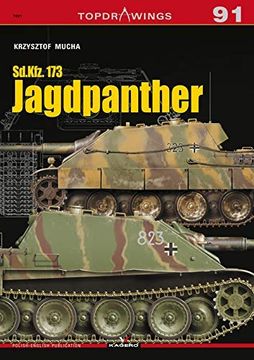Share
Jagdpanther: 7091 (Top Drawings)
Krzysztof Mucha (Author)
·
Kagero
· Paperback
Jagdpanther: 7091 (Top Drawings) - Krzysztof Mucha
£ 15.30
£ 17.00
You save: £ 1.70
Choose the list to add your product or create one New List
✓ Product added successfully to the Wishlist.
Go to My WishlistsIt will be shipped from our warehouse between
Friday, May 31 and
Monday, June 03.
You will receive it anywhere in United Kingdom between 1 and 3 business days after shipment.
Synopsis "Jagdpanther: 7091 (Top Drawings)"
Sd.Kfz. 173 Jagdpanther is a German tank destroyer developed by Krupp and Daimler-Benz. The order was placed in August 1943 and the vehicle entered service in the first months of 1944. It was armed with a very effective anti-tank tank gun. PaK 43 cal. 88 mm. The destroyer’s combat compartment was armoured with 40 to 100 mm thick (front plate) armour plates. From January 1944, 415 pieces were produced (at the MIAG, MNH and MBA factories). The vehicle was based on the chassis of the Panther Ausf. G, but it didn’t have as many technical problems as the mentioned tank. Due to the favourable power-to-weight ratio, Jagdpanther had good performance and maneuverability. Together with a powerful cannon, which was able to destroy any allied armoured vehicle that time, it made it an extremely effective and dangerous destroyer. Vehicles were used by independent tank destroyer battalions. Jagdpanthers debuted in Normandy in 1944 (within 555th and 654th Panzerjagerabteilung), achieving great successes. Also during the offensive in the Ardennes, the Allies took a toll on them. They appeared on the Eastern Front in the autumn of 1944, effectively fighting all Soviet armoured guns and heavy tanks, including IS-2. The vehicle was produced in two main variants. The early version – designated as G1 – had a smaller yoke that was welded to the hull, a modified engine compartment from the Panther Ausf. A and two driver’s visors. In the later version – G2 – the Panther Ausf. G engine compartment was used, one driver’s visor and a larger yoke which was bolted to the front plate with screws. There were also many hybrid variants combining the features of both versions. Until September 1944, Jagdpanthers were covered with Zimmerit in the form of characteristic squares, and not the more popular “snakes”. Jagdpanthers proved to be the most effective German tank destroyers, but they appeared too late and in too few numbers to significantly influence the course of the war.
- 0% (0)
- 0% (0)
- 0% (0)
- 0% (0)
- 0% (0)
All books in our catalog are Original.
The book is written in English.
The binding of this edition is Paperback.
✓ Producto agregado correctamente al carro, Ir a Pagar.

